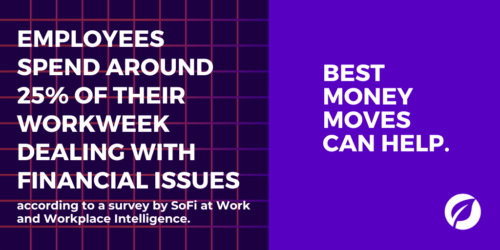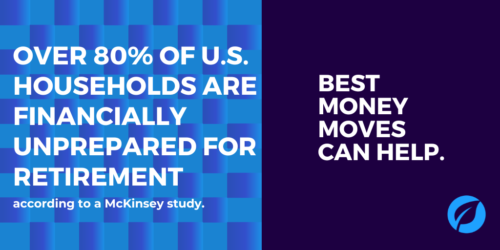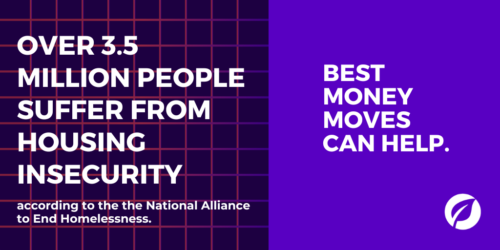
4 Ways to Help Your Employees Tackle Financial Stress
Between rising housing costs and continued inflation, U.S. workers are facing financial stress on all sides. According to a survey conducted by SoFi at Work and Workplace Intelligence, employees spend around 25% of their work week worrying about money, resulting in significant productivity loss. Another 45% of employees feel that their employer is unconcerned with their financial well-being.
Your employees want greater financial well-being and they’re looking to you for help managing financial strain. Best Money Moves is a financial wellness solution designed to help dial down employees’ most top-of-mind financial stresses.
Here are 4 common financial problems facing your employees and how Best Money Moves can help.
1 Address employee mental health strain by diagnosing the root causes of financial stress.
Employee mental health is top of mind for many employees in the post-COVID workforce. Not having a firm grasp on personal finances adds significant strain to employee wellbeing. 42% of American adults said money had a negative impact on their mental health as reported by Bankrate’s Money and Mental Health survey. That’s why diagnosing employee financial stress is at the heart of everything Best Money Moves does.
Using a unique tracking system known as the Stressometer, employees can measure their financial stress across 14 financial categories. Best Money Moves will map these stressors and use our unique content mapping system to connect each user to the financial resources they need the most. Identifying the root causes of financial stress is the first step toward alleviating financial anxiety.
2. Help employees build their financial literacy and make smarter financial decisions.
In a report conducted by Guardian, the average American worker could only answer about half of the questions of a standardized personal finance test. And it’s no surprise why — it’s often in the best interest of the financial services industry to keep consumers confused about their options.
However, your employees shouldn’t need a PhD in economics just to understand their finances. That’s why Best Money Moves prioritizes thoroughness and readability when it comes to financial education. Users gain access to a library of 800+ educational resources, including articles, videos, webinars, and more, about all kinds of money management strategies.
3. Employees are unprepared for a financial emergency. Help them catch up.
According to a survey by MagnifyMoney, 20% of Americans reported that they put $0 towards emergency savings during 2021. Successful savings starts with a strong budget, so Best Money Moves offers intuitive tools for both.
The Best Money Moves budget tool uses real-world data about an employee’s monthly income and living situation to create personalized budget goals (their Best Money Moves). Employees can organize their spending into a wide array of categories and receive alerts and guidance about areas of overspending.
Plus, with the Best Money Moves savings tools, users can also break long-term goals into smaller, more actionalabe monthly savings.
4. Address the specifics of financial stress by connecting employees to the guidance they need.
Providing employees with customized assistance to their finances can signal to employees that you’re listening to their needs. According to Morgan Stanley, 70% of employees say they’d be open to receiving personal financial support at work from a financial professional.
Best Money Moves offers high levels of customization and engagement, so your employees get the information, tools, solutions and products they need to live their best financial lives. Our latest, and most affordable, product is Best Money Moves Premium, which allows companies to personalize and contextualize the benefits they give to their employees, dramatically cutting down the time it takes to implement a full-service financial wellness program.
We have a full slate of award-winning, best-in-class benefits our customers can choose for their employees or end users, or companies can pull in their own benefits and use our triggers & alerts overlay to push the right benefit to the right person at the right point in time. Best Money Moves Premium is available as a zero-cost or low-cost white label solution to the problem of getting employees to engage with their benefits
Need a financial wellness solution for your team? Try Best Money Moves!
Best Money Moves is a mobile-first financial wellness solution designed to help employees meet their most top-of-mind financial goals. With budgeting tools and personalized money coaching, users can easily receive comprehensive financial advice right from their phones.
Focused on user-friendliness, Best Money Moves is designed to bring financial wellness resources right to the fingertips of employees. Our dedicated resources, partner offerings and 700+ article library make Best Money Moves a leading benefit in improving employee financial wellbeing.
To learn more about Best Money Moves Financial Wellness Platform, let’s schedule a call. Contact us and we’ll reach out to you soon.









